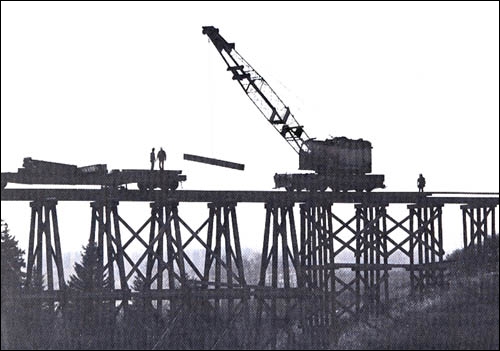
Volume 12
Number 1
Jan. 13, 1982
|
 |
MBS Rules Improve Communications and
Safety By Ken Emmond

Silhouette of Work: Jack
Wood's B&B gang strikes a heroic pose in silhouette with their massive auxiliary crane on the Lacombe
subdivision, near Nevis, Alberta. They are doing a routine job, renewing heavy decking timbers on this trestle
across Tail Creek out on the prairie east of Red Deer - Nicholas Morant.
 CP Rail has introduced manual Block System ( MBS ) rules to five
subdivisions in a move designed to streamline communications between dispatchers and train and work crews, and to
improve safety for maintenance crews.
CP Rail has introduced manual Block System ( MBS ) rules to five
subdivisions in a move designed to streamline communications between dispatchers and train and work crews, and to
improve safety for maintenance crews.
The system was introduced 15 Nov 1981 on all three subdivisions of the Esquimalt & Nanaimo Railway
- the 18-mile Lake Cowichan subdivision, the 39-mile Port Alberni subdivision, and the
140 miles of the Victoria subdivision. It also went into operation on 100 miles of track on the Wilkie subdivision
and on 131 miles of the Hardisty subdivision, both in the Saskatoon Division.
Under MBS rules, a dispatcher gives out train operation orders by radio. He tells train crews whether they can enter
a block, and whether they have to proceed at reduced speed.
The dispatcher must make sure a block has been cleared of traffic before allowing a train to enter it.
The dispatcher also grants track occupancy permits to protect men doing track maintenance, so that flag protection
is rarely needed. As a safety precaution, a dispatcher can only authorize trains or engines to enter a maintenance
area with the approval of a work foreman.
All five subdivisions had previously been on Train-Order Rules. Under that system, the train order
spells out the movement of the train, including speed limits, the locations at which it would meet other trains, and
the procedures to follow.
"The flexibility of this ( MBS ) method allows almost instantaneous changes in train movements as situations
arise", said Al Birkett, director of rules, training, and accident prevention in the Prairie Region.
He said the MBS will "expedite movement of traffic and enhance the productivity of men working on the
track".
Mr. Birkett was enthusiastic about the way things have been going in the first three weeks of MBS operation in the
Saskatoon Division.
"The initial results are better than anticipated", he said. "The general acceptance of the system by
the people involved is producing excellent results. Everybody seems to be quite pleased with it - crews,
dispatchers, and management".
SMOOTH TRANSITION
Milton Morrow, assistant superintendent of transportation for the Pacific Region, said, "We've had no problems.
The transition went smoothly and orderly".
Under the MBS, it is essential that there are no gaps in communication. As a result, three communications towers had
to be installed on Vancouver Island, and three were added in the Saskatoon Division. A fourth tower was moved to a
new location in the Saskatoon Division.
Training of crews and dispatchers began in October, and by mid-November there were about 400 Saskatoon
Division employees and about 150 in the Pacific Region that had become familiar with MBS.
This CP Rail News article is
copyright 1982 by the Canadian Pacific Railway and is reprinted here with
their permission. All photographs, logos, and trademarks are the property of the Canadian Pacific Railway
Company.
|